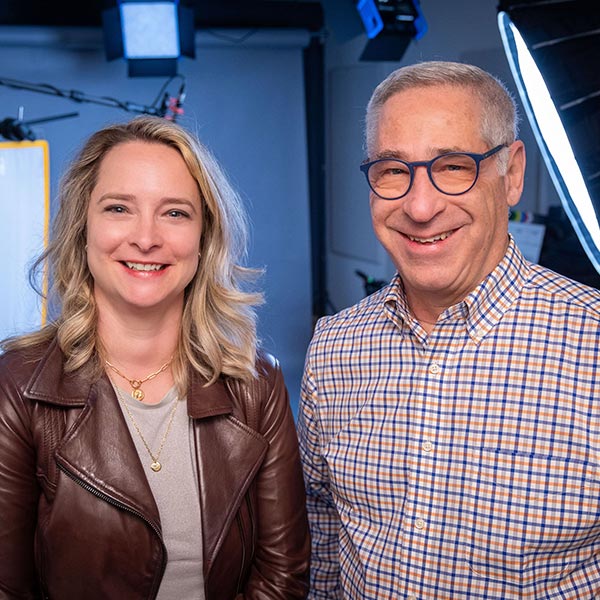It’s not an easy thing to sum up a 63-year research career, especially when you have accomplished as much as Michel Chrétien, MSc’62. At age 87, he is still working in his lab at the Institut de recherche clinique de Montréal (IRCM) and still practising medicine.
From his perspective, Chrétien’s career trajectory is fairly straightforward. “In one way or another, everything I’ve done is related to prohormones.”
His hugely influential “prohormone theory”, which he formulated in 1967 while completing a postdoctoral fellowship in chemistry at the University of California at Berkeley, helped explain a great mystery of the time: how hormones activate.
Research related to this breakthrough would see Chrétien become one of the world’s most cited medical scientists in the 1980s. He is a two-time winner of the Prix du Québec, having received both the Prix Wilder-Penfield Prize and the Prix Armand-Frappier. His long list of accolades includes the Order of Canada, the Ordre national du Québec, the Légion d’honneur, membership in the Royal Society of London, and induction into the Canadian Medical Hall of Fame.
“To have a successful career in research, you need good luck, plus smarts,” he says with the swagger of his Shawinigan roots. “But you also learn to live with being worried all the time because you never know how things are going to turn out.”
After completing a medical degree in 1960, Chrétien took advantage of a rare opportunity to join the lab of Dr. Jacques Genest, DSc’79, at Montreal’s Hôtel Dieu, while also doing a master’s degree at McGill.
At McGill, he was under the joint direction of Genest and Professor John Symonds Lyon (JSL) Browne, BA’25, MDCM’29, BSc(Med)’29, PhD’32, the head of McGill’s Department of Experimental Medicine at the time. Browne had opened his program to trainees from the Université de Montréal. “JSL Browne was a pioneer in bringing together the two solitudes,” says Chrétien.
Chrétien, who went on to do post-graduate studies at Harvard, benefitted greatly from working with these two mentors. Not only did Browne’s reputation in endocrinology open doors for him at Harvard, Genest had also made a name for himself in the field of hypertension, a hot new area of research at the time. “I had basically been following orders in Montreal,” says Chrétien, “but by the time I got to Boston I came off as being quite knowledgeable.”
For his postdoctoral research, the young scientist decided to go against the tide and join the lab of the eminent biochemist Choh Hao Li at Berkeley. “Nobody in the lab understood what a [medical] doctor was doing there, but I had the feeling that to be a good endocrinologist, I would also have to study chemistry.”
Chrétien’s new supervisor assigned him the job of sequencing a relatively simple hormone. The work was repetitive – it takes three days to isolate one amino acid, and the hormone in question had 90 – but performing the meticulous labour focused his attention on an unknown mechanism.
At the time, no one had a clear understanding of how hormones were activated. Most hormones in the human body are proteins and Chrétien developed the notion that active proteins originated from longer, inactive proteins that were cleaved by molecular knives he would call “convertases.” The theory of prohormones, which he published in 1967 at the age of 30, opened a new chapter in neuroendocrinology.
Chrétien’s theory would turn out to have many applications. Numerous researchers went on to extrapolate from it, which led to further discoveries, notably in the understanding and treatment of diabetes, obesity, and hypercholesterolemia.
Chrétien didn’t stop there. Having created the first protein chemistry laboratory in Quebec at the IRCM in 1967, he discovered human beta-endorphin in 1976, which allowed him to demonstrate that his theory was very real: convertases did indeed exist. But it would take him another 14 years to identify the first two, in collaboration with Nabil Seidah and Majambu Mbikay. Convertases are now recognized as forming a family of nine enzymes, seven of which were discovered at the IRCM.
Chrétien’s contributions to the IRCM were not restricted to the discoveries made in his lab. He was its scientific director from 1984 to 1994, and he takes pride in the fact that the number of women appointed to senior positions grew considerably at the IRCM during this period. New research units were also created on his watch.
His own research career continues. He is currently investigating the mutation of a gene in some French-Canadian families that lowers cholesterol and protects carriers from cardiovascular and liver disease. “As it turns out, the wife of one of my nephews is a member of the carrier group.” When examining Chrétien’s impact on the research landscape in this country, another noteworthy family connection pops up.
My brother, the Prime Minister
Historians of science interested in Canada will certainly be keen on exploring the behind-the-scenes role Chrétien played at the turn of the millennium.
Michel Chrétien is the youngest of 19 children from a family in Shawinigan, the 18th of whom, Jean, would go on to be Prime Minister of Canada from 1993 to 2003. “I would say I had a subtle influence on my brother.”
Even before Chrétien became the scientific director of the IRCM in 1984, Jean Chrétien had overseen a series of ministries in Pierre Elliott Trudeau’s governments, many of them with an economic focus (Treasury Board; Industry, Trade and Commerce; Finance; Energy, Mines and Resources). “Whenever we got together, we talked about our work, but my main goal was to get him to understand how useful and economically beneficial basic research was,” says Chrétien.
Chrétien went to great lengths to make the case for funding research. He even asked a young economist at the time, Léon Courville, to conduct a study on the economic benefits of basic research. The economist spent several years working on the project. “It was seminal work. I got my brother to read the study and even brought Leon to see him in his office.”
In The Way It Works, a memoir about his days as one of Jean Chrétien’s top advisors, Eddie Goldenberg, BA’69, MA’71, BCL’74, LLD’04, cites Michel Chrétien as an important influence on many of the research-friendly initiatives of his brother’s government – like the Canada Foundation for Innovation and the Canada Research Chairs program. “The prime minister liked to say that Michel was more effective than anyone in pleading the case for government support of research,” Goldenberg wrote.
“I’m firmly convinced that science is essential in any self-respecting modern, democratic society,” Chrétien says, adding a word of warning. “But for it to work, we need to respect the academic and administrative freedom of research.”
Science in Quebec
Chrétien is optimistic about the future of scientific research in Quebec, even at a moment when researchers in other parts of the world, like China and India, are making impressive gains. “Quebec remains competitive. Canada and Quebec have developed solid policies and are investing in them.”
In his eyes, renowned Quebec scientists like Armand Frappier and Jacques Genest were important precursors of the Quiet Revolution. “I frequently consulted Frappier, who was very wise. He’s a hero to me.”
Chrétien believes that the creation of the IRCM was a fundamental step for Quebec research. “We don’t have 1,500 researchers like the Pasteur Institute does, but like them, we are independent of the government and even of universities. We’re not under anyone’s tutelage. Some civil servants don’t like that, but we do our own thing, and that’s important.”
Like the IRCM, he says Quebec is known for having an independent approach that is very distinct from that of the Americans, the British and the French. “We do our science our own way and we get great results.”
Since the early 1960s, Quebec researchers have benefitted from the support of the Quebec government, the first province in Canada to adopt this approach. “In Canada, Quebec scientists are the best funded per capita,” he says. And, in Chrétien’s view, Quebec researchers have proven that they are worthy of that investment. “If you add up the output of McGill, Université de Montréal, and Concordia, we beat Toronto for the quantity and quality of our research. So, yes, I’m optimistic about the future.”
by Jean-Benoît Nadeau, BA’92 (translated by Julie Barlow, BA’91)


